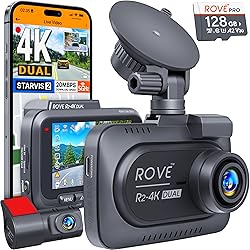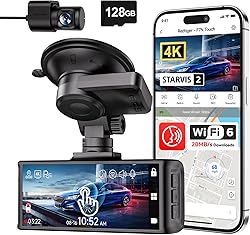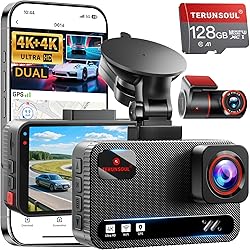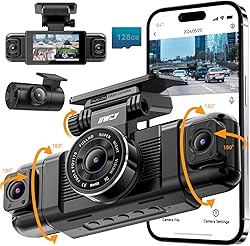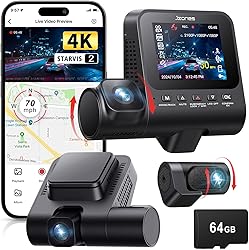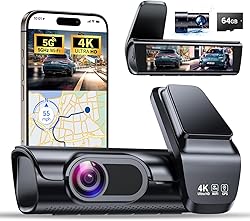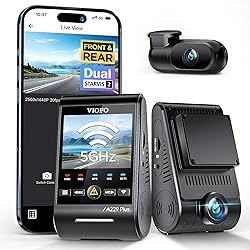I’ve tested more dash cams than I care to admit, but finding a solid dual cam setup is still one of my favorite deep dives. A front and rear camera system isn’t just a nice-to-have anymore. With more traffic, distracted drivers, and parking lot nonsense than ever, it’s a smart move for your peace of mind—and maybe your insurance.
The tricky part is picking the right one. Some models look great on paper but fumble the basics like night clarity or mounting stability. Others quietly get it all right without breaking the bank. In this roundup, I’ve narrowed down the options to the best dash cams front and rear that really impressed me in real-world driving. Whether you’re after rock-solid reliability, crisp video, or features that actually help after an accident, I’ve got you covered.
Best Front And Rear Dash Cams in 2025
| Image | Model | |
|---|---|---|
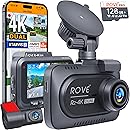 | Best Overall ROVE R2-4K DualEditor's Choice Check Price | Check Price |
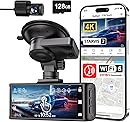 | Best Value REDTIGER F7N TouchCheck Price | Check Price |
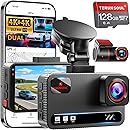 | Best Dual 4K Dash Cam Setup Terunsoul 4K+4KCheck Price | Check Price |
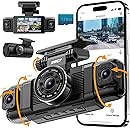 | Best Full 360° Coverage Dash Cam IIWEY N5 360°Check Price | Check Price |
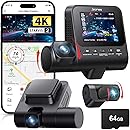 | Best 3-Channel Dash Cam Jzones 3-ChannelCheck Price | Check Price |
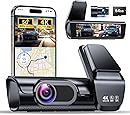 | Best Budget OVAMAN K600 4KCheck Price | Check Price |
 | Best Dual-Cam Quality VIOFO A229 PlusCheck Price | Check Price |
1. ROVE R2-4K Dual Dash Cam
ROVE has managed to hit a sweet spot with the R2-4K Dual—it’s one of those rare front and rear dash cams that actually delivers the premium experience its specs suggest. With true 4K up front and full HD in the rear, it records crystal-clear footage, day or night. The Sony STARVIS 2 sensor really pulls its weight here, making night drives look surprisingly vivid and accurate. I also appreciated the included 128GB microSD card—no need for an extra trip to the store just to get things running.
But what really makes this dash cam stand out is the built-in 5GHz WiFi and GPS. Downloading footage straight to your phone is actually fast (not just marketing fluff), and the GPS data overlay is a killer feature if you ever need it for insurance claims. The app experience is a breath of fresh air—intuitive, no sketchy logins, and it doesn’t feel like a clunky afterthought. Setup took a bit longer than average due to cable routing for both cameras, but everything needed was in the box, and the guide was refreshingly clear. Minor gripe: I wish it had USB-C for power instead of needing an adapter—but once in place, the system just works.
Pros:
- Excellent 4K front and 1080p rear video quality, even in low-light
- Super fast WiFi transfers via 5GHz and easy-to-use app
- Built-in GPS overlays speed and coordinates on footage
- Includes 128GB microSD card—ready out of the box
Cons:
- Rear camera mount could be sturdier and easier to position
- Requires adapter for USB-C power in newer cars
2. REDTIGER F7N Touch 4K Dash Cam
This REDTIGER F7N Touch felt like a breath of fresh air after fiddling with clunky button-controlled dash cams. The responsive 3.18-inch touchscreen is a joy to use, and with full 4K up front and 1080p in the rear, you’re getting seriously crisp footage—day or night. The STARVIS 2 sensor really helps in low-light situations, capturing headlights and license plates with surprising clarity.
Setup was straightforward right out of the box, and it even comes with a 128GB memory card—one less thing to worry about. Connecting it via the app over 5GHz WiFi made syncing footage quicker than I expected. Voice control is a nice touch (pun intended), though it does need a beat or two to register commands. GPS logging is built-in so you can track routes and speeds if needed, and parking mode is a handy safety net too—just keep in mind you’ll need a hardwire kit for full functionality.
Minor nitpicks? The manual feels a little barebones, and syncing rear and front footage isn’t perfect if you get deep into time-lapse mode. But overall, this dual-cam setup nails the sweet spot between premium features and a user-friendly interface.
Pros:
- Sharp 4K front and 1080p rear video quality
- Responsive touchscreen and voice control
- Includes 128GB card and fast 20MB/s WiFi transfer
- Excellent customer support from Redtiger
Cons:
- Time-lapse recordings use up memory fast
- Manual could be more detailed
3. Terunsoul 4K+4K Dash Cam Bundle
Dual true 4K isn’t something you see every day in the dash cam world, especially at this price point. But the Terunsoul unit offers precisely that — and throws in a 128GB microSD card just to sweeten the deal. Hookup was easy enough, and once it was up and running, I was blown away by the sharpness of the video. Both the front and rear cameras record crisp, detailed footage that picks up everything — daylight or night, rain or shine.
The real standout for me here is the Wi-Fi. The 5.8GHz connection is fast, really fast, making it effortless to pull footage to my phone without fiddling around with SD cards. Combine that with GPS tagging, and you’ve got a full suite of critical data on your side if you ever find yourself needing to review an incident. It’s sleek, it’s smart, and it doesn’t hog space on the windshield. Just make sure you’re prepped for the extra wiring the rear cam entails — it’s manageable, but planning helps.
With features like Super Starlight Night Vision, 24-hour parking monitoring (with a separate hardwire kit), and simple in-app controls, this thing covers all the bases without feeling overwhelming. It’s a well-rounded setup built for real-world driving — especially if you like having insurance-grade clarity without paying a premium for it.
Pros:
- Crystal-clear 4K front and rear video recording
- Fast 5.8GHz Wi-Fi makes file transfer a breeze
- Comes with a 128GB microSD card
- Reliable GPS logging and comprehensive app control
Cons:
- Rear camera setup requires careful cable routing
- Separate hardwire kit needed for full parking mode
4. IIWEY N5 4-Channel 360° Dash Cam
Let me just say—if you’re looking for full visibility around your vehicle, the IIWEY N5 delivers it in spades. This four-channel system covers every angle: front, rear, left, right, and even the cabin. It’s like putting your car in its own surveillance bubble. Setup was refreshingly straightforward, and I appreciated that it came with the 128GB SD card already installed. With wide 170° and 150° lenses, those blind spots practically vanish.
The image quality is solid across the board. All channels record in 1080P, which gives clear footage both day and night, thanks in part to the onboard IR lights. WiFi connectivity lets me grab footage straight to my phone using their app—just know you’ll need to press a button to activate WiFi, and it times out after a bit. That’s one of those quirks you get used to. The dash cam runs exclusively off your car’s power, so be ready to use the included charger or spring for a hardwire kit if you want parking mode on 24/7.
One note: it doesn’t have GPS, and the cords are a bit messy unless you’re really into tidying up your install. But for under a hundred bucks, the all-around coverage and decent app integration are hard to beat.
Pros:
- True 360° recording with four cameras
- Clear 1080P footage from all angles
- Includes free 128GB SD card
- Easy phone access via 5GHz WiFi
Cons:
- No GPS functionality
- WiFi disconnects fairly quickly
5. Jzones 3-Channel 4K Dash Cam
If you’re trying to cover every corner inside and outside your ride, the Jzones 3-channel dash cam offers a serious trifecta: 4K up front, dual 1080p for the rear and cabin. The result? Clear, crisp, multi-angle footage that makes blind spots practically disappear. Whether you’re a rideshare driver, road trip warrior, or just want to keep an eye on teen drivers, this setup is like having a second pair of eyes everywhere.
I found the night vision performance better than expected thanks to that STARVIS 2 sensor—it holds up well against glare and dimly lit streets. It also adapts quickly to changes in light (like when passing under overpasses), so you don’t lose important detail. Add in GPS logging, Wi-Fi 6 for snappy footage transfers, and loop recording with impact detection, and the Jzones becomes as much of a security tool as it is a camera. Plus, they throw in a 64GB card, so it’s ready to roll out of the box.
Pros:
- Crystal-clear 4K and 1080p video on all channels
- Excellent night vision with responsive light adjustment
- Built-in GPS and fast Wi-Fi 6 connectivity make footage access easy
- 24-hour parking mode adds extra peace of mind
- Includes 64GB memory card
Cons:
- Wired kit required (not included) for parking mode to function
- App interface could be more intuitive for first-time users
6. OVAMAN K600 4K Dual Dash Cam
When I installed the OVAMAN K600 in my ride, I immediately noticed how crisp the video looked. We’re talking sharp 4K in the front and solid 1080p out back — not the gimmicky kind of resolution you sometimes see slapped on budget cams. The clarity made it easy to make out license plates, even after dark thanks to some impressive low-light performance. Pair that with a wide 170° field of view and you’re covered from nearly every angle.
The 3.59-inch screen is a nice touch — bright enough to see even in daylight and big enough to navigate the settings without squinting. I was also pleasantly surprised at how smooth the app experience was with 5G WiFi. Connecting my phone didn’t require a tech degree, and I could grab footage or tweak settings without needing to fiddle with the SD card. And speaking of which, it comes with a generous 64GB card already included — something that still feels like a small luxury in this price range.
Built-in GPS handles speed and location logging automatically, which is great if you ever have to back up your story after an accident. The 24-hour parking mode is a solid feature too, especially if you’re leaving your vehicle in public lots often — just remember you’ll need a separate hardwire kit for that.
Pros:
- Sharp 4K front + 1080p rear video quality
- Wide-angle lenses for excellent road coverage
- WiFi app makes downloading and sharing clips easy
- Comes with a 64GB SD card
- Built-in GPS for speed and location tracking
Cons:
- Parking mode requires additional hardwire kit
- WiFi setup isn’t fully intuitive the first time
7. VIOFO A229 Plus Dual STARVIS 2 Dash Cam
The VIOFO A229 Plus was one of those products that impressed me from the moment I hit “record.” What sets this front and rear dash cam apart is the image quality – not just during the day, but especially in low light. Thanks to the twin STARVIS 2 sensors, details like license plates and road signs stay clear even in murky nighttime settings. I’ve driven with it through city traffic, dark rural roads, and even during a heavy downpour, and the footage consistently came out detailed and usable.
One welcome feature was the voice control – being able to tell the camera to take a photo or lock a file without fiddling with buttons is surprisingly handy while driving. Installation wasn’t bad at all, especially with the included trim tool, and routing the rear camera cable felt more straightforward than expected. I did get a minor “slow card” warning at one point, but after reformatting the card and making sure it was a high-endurance type, I didn’t see that again. The GPS is tight, Wi-Fi transfer is snappy on 5GHz, and the build quality gives confidence it’ll hold up long-term.
There’s no SD card or hardwire kit included, which is worth noting, especially if you want to fully use the 24/7 parking mode features. But even with that caveat, the A229 Plus feels like a premium dash cam package without the luxury price tag. If clear, high-definition video is your priority – regardless of day or night – this one delivers in spades.
Pros:
- Outstanding image quality day and night with STARVIS 2 sensors
- Hands-free voice commands are genuinely useful while driving
- Super precise GPS and fast 5GHz Wi-Fi make data handling easy
- Durable construction with temperature protection for year-round use
- Great customization through companion app
Cons:
- Doesn’t include SD card or hardwire kit for parking mode
- Needs a high-speed memory card to avoid slow card warnings
Key Features to Look For
When shopping for a dual-channel dash cam system, video resolution should be your first priority. Look for at least 1080p front recording with 720p rear minimum, though I’d strongly recommend going for 4K front if your budget allows. Trust me, when you’re trying to read a license plate that cut you off at 65mph, those extra pixels matter more than you’d think. I learned this the hard way when my old 720p cam couldn’t catch the plate of a hit-and-run driver in my shop’s parking lot.
Field of view is another critical spec that most people overlook. You want around 140-170 degrees for the front camera and at least 120 degrees for the rear. Anything less and you’ll miss side-impact scenarios or lane-change incidents. Night vision capability separates the good cams from the paperweights — look for Sony sensors or similar low-light performers, because most accidents happen when visibility is already compromised.
Storage and Loop Recording
Here’s where things get technical but stay with me. Get a cam that supports at least 128GB microSD cards, preferably with Class 10 or U3 rating for write speeds. The cheap cards will fail you when you need them most, and nothing’s more frustrating than discovering your “evidence” is corrupted footage of digital noise. I’ve seen too many customers learn this lesson the expensive way.
Loop recording should be seamless with G-sensor integration. When the accelerometer detects impact, it needs to immediately protect that file from being overwritten. Some budget models have wonky G-sensor calibration that either triggers constantly from potholes or fails to activate during actual incidents.
Installation Considerations
Professional installation isn’t just about looking clean — it’s about reliability. Hardwiring your dash cam to the fuse box provides constant power for parking mode and eliminates the cigarette lighter cable clutter. However, this requires knowledge of your vehicle’s electrical system and proper fuse selection. Don’t just tap into any random fuse or you’ll end up draining your battery overnight.
For the rear camera, running the cable properly is crucial. I always route it under the headliner, down the A-pillar, under door seals, and up through the rear cargo area. It sounds complicated, but taking shortcuts with cable routing leads to interference, wear points, and that lovely rattling sound that’ll drive you insane on long trips.
Parking Mode and Power Management
Parking mode is where dual-channel systems really shine, but it’s also where they can kill your battery. Quality units include voltage monitoring that cuts power before your battery drops too low to start the car. Set this threshold at 12.0V for most vehicles, though some European cars might need 12.4V. I’ve jumped more dead batteries from poorly configured parking mode than I care to count.
Legal and Privacy Factors
Dashboard camera laws vary significantly by state, and some have specific restrictions on recording audio or rear-facing cameras. Audio recording can actually hurt you legally in two-party consent states if you’re recording passengers or other drivers without permission. Most quality units let you disable audio recording entirely, which I recommend for most users.
Commercial drivers face additional regulations under FMCSA guidelines that specify recording requirements and driver privacy protections. If you’re running a fleet or commercial vehicle, make sure your chosen system meets federal compliance standards.
Common Installation Mistakes
The biggest mistake I see is mounting the front camera too low on the windshield, blocking the driver’s view or interfering with airbag deployment zones. Keep it behind the rearview mirror and above the windshield wiper sweep area. Your state inspection might fail you if the camera blocks too much windshield real estate.
Cable management seems simple until you’re dealing with tight spaces and factory wiring. Never run power cables next to airbag wiring harnesses, and always use proper automotive-grade fuses and fuse taps. The $3 you save on cheap electrical connectors isn’t worth the fire risk or insurance headache later.
- Always test parking mode before leaving your car overnight
- Format your SD card monthly to prevent corruption
- Check local laws regarding windshield mounting restrictions
- Verify your car’s electrical system can handle the additional load
Cloud Connectivity and App Features
Modern dash cams have gotten smart, maybe too smart for their own good sometimes. Wi-Fi connectivity lets you review footage on your phone without pulling the SD card, which is genuinely useful when you need to share evidence with police or insurance right at the scene. But here’s the catch – some manufacturers lock basic features behind subscription paywalls for cloud storage or “premium” app functions.
I’m not against paying for cloud storage if you actually need it, but make sure the core functionality works without monthly fees. GPS tracking, speed logging, and real-time alerts should be included with the hardware you already paid for. Check app store reviews before buying – nothing’s worse than a $300 dash cam with a 2-star app that crashes constantly.
WiFi vs Bluetooth vs LTE
WiFi is the standard for transferring video files because it’s fast enough for HD footage. Bluetooth is fine for quick settings changes or notifications but useless for pulling actual video. Some high-end models now include LTE for live streaming and cloud backup, which sounds cool until you realize you’re paying for another data plan and the upload speeds eat through your monthly allowance faster than a teenager on social media.

